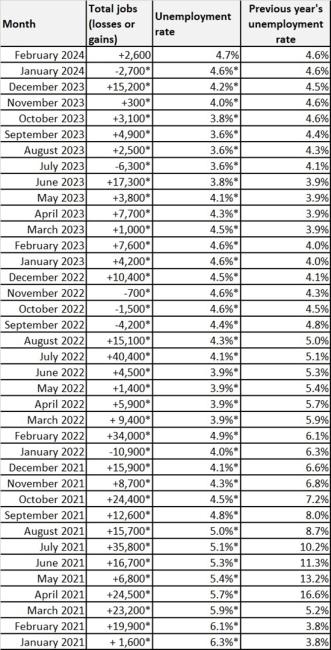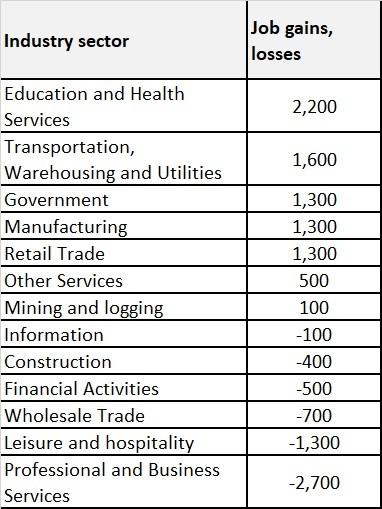Released on
FOR IMMEDIATE RELEASE
Contact: media@esd.wa.gov
Payroll employment increased in February; unemployment rose to 4.7%
OLYMPIA – Washington’s economy added an estimated 2,600 jobs (seasonally adjusted) and the monthly unemployment rate rose from 4.6% in January to 4.7% in February.
Last month’s unemployment rate is the highest recorded rate since 2021. It also marked the fifth consecutive month of increasing unemployment rates in Washington.
Job growth remains positive, but the overall trend has slowed in recent months as net employment continues to increase in some industries and decrease in others.
'Over the past several months, the unemployment rate has increased bit by bit,' said Employment Security Department (ESD) Chief Labor Economist Anneliese Vance-Sherman. 'That 4.7% unemployment rate signals a possible shift from an unusually tight labor market that characterized the post COVID-19 pandemic period.'
ESD paid unemployment insurance benefits to 74,090 people in February, a decrease of 3,602 paid claims over the previous month. Seasonal decreases in paid claims within agriculture and construction – industries that are typically more active during warmer seasons – contributed to the overall decrease in claims over the month.
Visit ESD’s website to view the entire Monthly Employment Report for February 2024.
Updated state preliminary data for January 2024
- The preliminary estimated loss of 3,600 jobs was revised to a loss of 2,700 jobs.
- The seasonally adjusted monthly unemployment rate was confirmed at 4.6%.
'January losses were not as deep as initially reported and were followed by job growth in February,' said Vance-Sherman. 'This is consistent with a trend of slowing job growth over the past year.'
National unemployment rate
The national unemployment rate bumped up to 3.9% in February. For comparison, the national unemployment rate (revised) for February 2023 was 3.6%.
Labor force showed little change
From January to February 2024, the number of people who were unemployed statewide increased from 183,684 to 190,891. In the Seattle/Bellevue/Everett region, the number of people who were unemployed increased from 68,611 to 71,911 over the same period.
The state’s labor force in February was 4,027,986 – a decrease of 5,006 people from the previous month. In the Seattle/Bellevue/Everett region, the labor force decreased by 2,473 people during the same period.
Labor force is defined as the total number of people, both employed and unemployed, over the age of 16. Layoffs and labor force participation are not necessarily connected. When people are laid off but still seeking work, they remain a part of the labor force. A drop in the labor force means people have left work and haven't been actively seeking employment for more than four weeks.
Seven major industry sectors add jobs, six shed jobs in February
Private sector employment increased by 1,300 jobs from January to February. Government employment also increased by 1,300 jobs.
Of the industry sectors, in February:
- Seven expanded.
- Six contracted.
The largest sector level gains in private industry were in education and health services (up 2,200), and transportation, warehousing and utilities (up 1,600). The deepest losses came from professional and business services (down 2,700).
Here are some key increases and decreases within these three sectors:
- The largest gains in the education and health services sector were in private education services (up 2,500).
- One-month losses in the professional and business services sector included scientific and technical services, management of companies and enterprise, and administrative and support services.
Annual employment growth appears in education, government, and leisure and hospitality
Washington gained an estimated 52,000 jobs from February 2023 to February 2024, not seasonally adjusted. Private sector employment rose by 1%, up an estimated 31,300 jobs, while public sector employment rose by 3.6% — up an estimated 20,700 jobs.
From February 2023 to February 2024, eight major industry sectors expanded and five decreased.
The three industry sectors with the largest employment gains year over year, not seasonally adjusted, were:
- Education and health services, up 24,000 jobs.
- Government, up 20,700 jobs.
- Leisure and hospitality, up 15,500 jobs.
The three industry sectors with the largest employment losses year over year, not seasonally adjusted, were:
- Information, down 8,600 jobs.
- Construction, down 7,500 jobs.
- Retail trade, down 5,600 jobs.
Table 1: Washington’s total jobs

*Revised from previous preliminary estimates. Preliminary monthly estimates for job losses or gains are based
on a small Bureau of Labor Statistics payroll survey. Actual figures reported the following month are based on
a more complete survey.
Table 2: January job gains and losses by industry

Labor market information
See more labor market information and tools, including interactive Tableau graphics, to highlight popular information and data.
WorkSource
Employment Security is a proud partner in the statewide WorkSource system, which provides employment and training assistance to job seekers and businesses. WorkSourceWA provides access to thousands of Washington jobs and other employment resources. WorkSource staff can connect job seekers with employers hiring right now in their community, identify training opportunities or help them brush up on application and interview skills. Job seekers and employers can find their nearest WorkSource center on the WorkSource office locator page.
Learn more about ESD’s monthly employment reports
Every month, the Employment Security Department publishes preliminary seasonally adjusted estimates for the prior month’s job growth and unemployment. We also publish confirmed data for the month before last. See the entire Monthly Employment Report on our website.
Monthly Employment Report publication schedule for 2024
|
Preliminary data for the month |
State and Metropolitan Division data release |
All other county data released |
|---|---|---|
|
February |
March 20, 2024 |
March 26, 2024 |
|
March |
April 17, 2024 |
April 23, 2024 |
|
April |
May 22, 2024 |
May 28, 2024 |
|
May |
June 20, 2024 |
June 25, 2024 |
|
June |
July 17, 2024 |
July 23, 2024 |
|
July |
Aug. 14, 2024 |
Aug. 20, 2024 |
|
August |
Sept. 18, 2024 |
Sept. 24, 2024 |
|
September |
Oct. 16, 2024 |
Oct. 22, 2024 |
|
October |
Nov. 13, 2024 |
Nov. 19, 2024 |
|
November |
Dec. 18, 2024 |
Dec. 24, 2024 |
|
December |
Jan. 22, 2025 |
Jan. 28, 2025 |
U-6 unemployment rate
The U.S. Bureau of Labor Statistics (BLS) updated its 'alternative measures of labor underutilization' for states to include annual averages for 2021. One such alternative measure is the U-6 rate, which considers not only the unemployed population in the official 'U-3' unemployment rate, but also marginally attached workers and those employed part time for economic reasons. The U-6 rate is defined by BLS as the 'total unemployed, plus all marginally attached workers, plus total employed part time for economic reasons, as a percent of the civilian labor force plus all marginally attached workers.' This U-6 measure measures the 'unemployed, underemployed, and those who are not looking but who want a job.'
Washington’s U-6 annual average unemployment rate for the four-quarter period through fourth quarter 2023 was 8.1%. This is above the 7.5% average for the four-quarter period through third quarter 2023. The U.S. U-6 average for the four-quarter period through fourth quarter 2023 was 6.9%.

